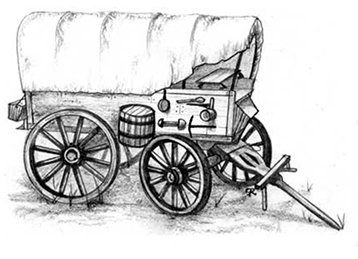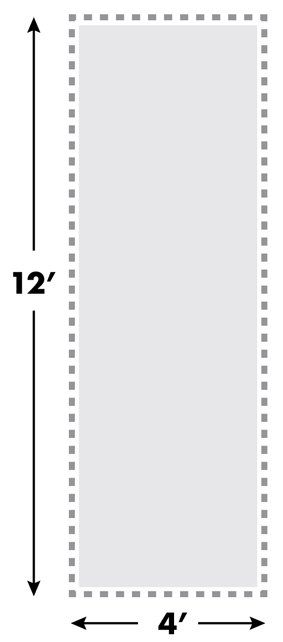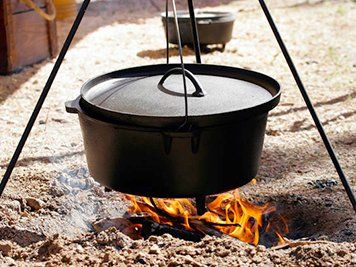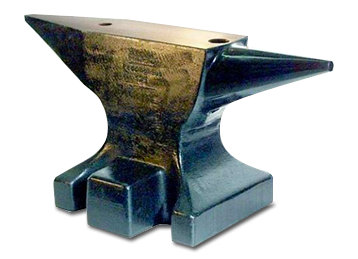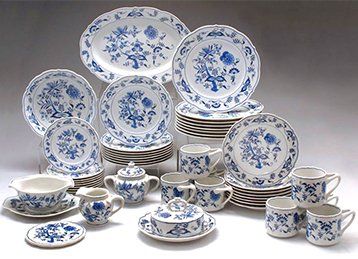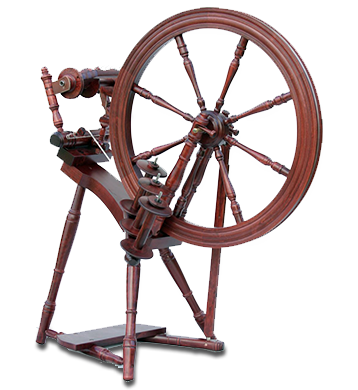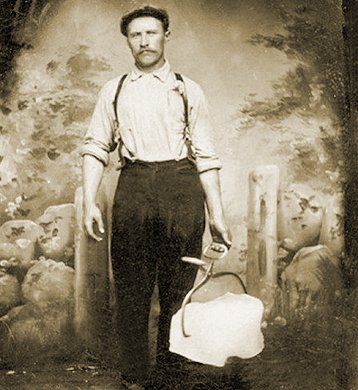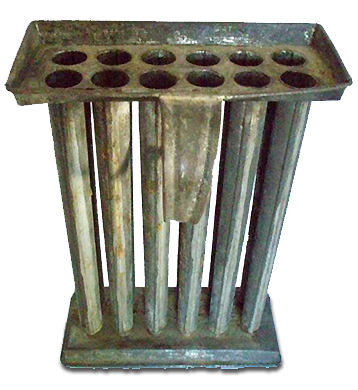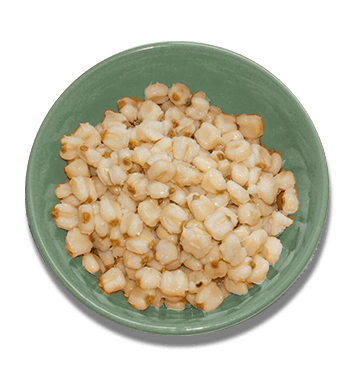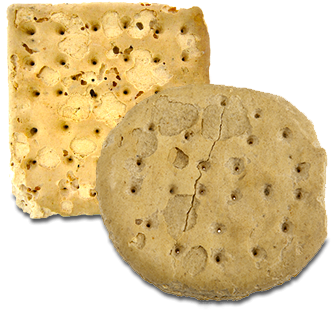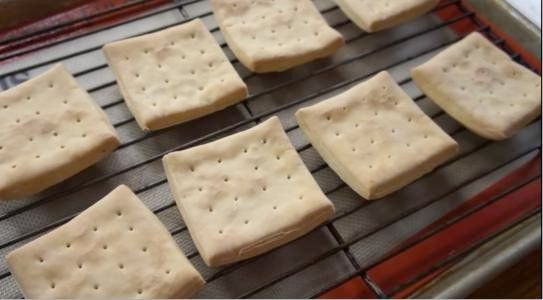The fun and educational activities below will help your students learn about the trip west that many pioneers took by covered wagon in the early 1800s.
Quad City Teachers – Gretchen Small, Director of Programs, can come to your classroom to lead your students through what the pioneers experienced on their trip west. Contact her at gsmall@butterworthcenter.com or 309-743-2701.
Following the War of 1812, pioneers began to move west as new states were founded (ie. Louisianna, Indiana, Mississippi, Illinois and others). In the 1830s and 40s, the flood of people heading west ballooned, causing the population of these states to grow as people traveled farther west across the Mississippi River.
In 1836, John Deere was one of those pioneers heading west from Vermont to Grand Detour, Illinois. The following spring, his wife Demarius and their five children also traveled west to join John. John traveled west first to check out the area and to build a blacksmith shop so he could start earning a living.
In 1836, John Deere was one of those pioneers heading west from Vermont to Grand Detour, Illinois. The following spring, his wife Demarius and their five children also traveled west to join John. John traveled west first to check out the area and to build a blacksmith shop so he could start earning a living.
FIRST, IT'S VOCABULARY TIME!
LET’S MAKE A COVERED WAGON
You can find many instructions online to make a covered wagon, from simple to very complicated. Here is an example of an easy method.
We have found that this wagon and horse work best if printed on cardstock paper or glued to the back of a cereal box. The wagon can also be stapled or taped to both sides of a toilet paper roll.
Have fun coloring, cutting out and assembling your wagon and horse, or make more than one horse. Wagons typically had at least two horses or two oxen. The larger Conestoga wagons often needed 8 horses or 10-12 oxen. Demarius Deere probably had a team of 2-4 horses.
LET’S DECIDE WHAT TO LOAD IN THE WAGON FOR THE TRIP WEST
The average pioneer wagon bed measured 4’ x 12’ and could potentially hold 2,000 pounds of people and supplies. Of course, this does not mean that one wagon with 2,000 pounds of supplies was pulled by one horse or oxen. Remember, it took at least two animals to pull this weight. To help you visualize the size of a typical wagon, measure out on the floor 4’ x 12’ and mark with masking tape.
To prepare for the trip west, pioneers spent a lot of time getting ready for this big undertaking. They had to make sure the wagon was in good repair, prepare the canvas covering to protect their supplies from rain, and make or purchase all the supplies. The preparations could not all be done in a weekend. Weeks of planning were undertaken. Pioneers did not want to get on the trail west and then have problems, if they could avoid it.
LET’S DO SOME MATH
Start with adding up the estimated weights of the family members and subtract from 2,000 pounds.
This will tell you how many supplies in weight you can load into your wagon. Not everyone in the family would ride in the wagon. Many pioneers would have walked beside it. Only the smallest children, or the injured, would have ridden in the wagon, which left more room for supplies.
Demarius Deere 125
pounds
Francis Albert (age 9) 65 pounds
Jeannette (age 7) 50 pounds
Ellen (age 5) 40 pounds
Frances Alma (age 3) 35 pounds
Charles Henry (age 5 months) 18 pounds
Francis Albert (age 9) 65 pounds
Jeannette (age 7) 50 pounds
Ellen (age 5) 40 pounds
Frances Alma (age 3) 35 pounds
Charles Henry (age 5 months) 18 pounds
A good method to decide what to take is to set up a chart.
Open the link to a list of possible items to load in the wagon. Approximate weights have been added for each item.
Dutch Oven
ButtonView more
Start filling out your “Take” or “Leave Behind” list. When ready, add up the weight of items and then subtract from 2,000 pounds. Are you under 2,000 pounds? Add more to your “Take” list. Are you over 2,000 pounds? What should you “Leave Behind”?
Once you have your wagon load list completed, let’s go one step further.
Once you have your wagon load list completed, let’s go one step further.
Imagine you are on your trip and have two oxen pulling your full wagon. Sadly, one of the oxen dies. There is no way you can replace the ox, and the trip must go on.
Hint: Each ox can pull 1,000 pounds. What must happen? Subtract again! Think about which supplies you will need to survive.
COOKING TIME!
It is always fun for kids to get in the kitchen, measure out ingredients, and cook.
Hardtack was a staple for the pioneer wagon. It was long-lasting and filling for the strenuous journey. During the Civil War in the early 1860s, soldiers also relied on hardtack as part of their daily food rations.
Hardtack was a staple for the pioneer wagon. It was long-lasting and filling for the strenuous journey. During the Civil War in the early 1860s, soldiers also relied on hardtack as part of their daily food rations.
Hardtack
1 1/2 Cups unbleached all-purpose flour
1 1/2 teaspoons salt
Mix flour and salt together in a bowl. Add water a little at a time mixing it into the flour mixture. Continue to slowly mix in water until the dough forms a ball and is not sticky. Put a little flour on the table and place the ball of dough on the floured table. Roll it out with the rolling pin until it is about ¼ inch thick. Cut the dough into squares. Next, take a nail and uniformly and gently push holes into the dough. Will look like a saltine cracker? Place the squares on a cookie sheet.
1 1/2 teaspoons salt
Mix flour and salt together in a bowl. Add water a little at a time mixing it into the flour mixture. Continue to slowly mix in water until the dough forms a ball and is not sticky. Put a little flour on the table and place the ball of dough on the floured table. Roll it out with the rolling pin until it is about ¼ inch thick. Cut the dough into squares. Next, take a nail and uniformly and gently push holes into the dough. Will look like a saltine cracker? Place the squares on a cookie sheet.
The hardtack is ready for baking at 350 degrees. It will not turn brown like a cookie, so baking about 20 minutes should be enough.
The hardtack tastes pretty good when it is warm from the oven. But imagine it weeks later when pioneers and soldiers would have broken the hardtack up into their food being cooked over a fire or dipped in their coffee to soften it.

